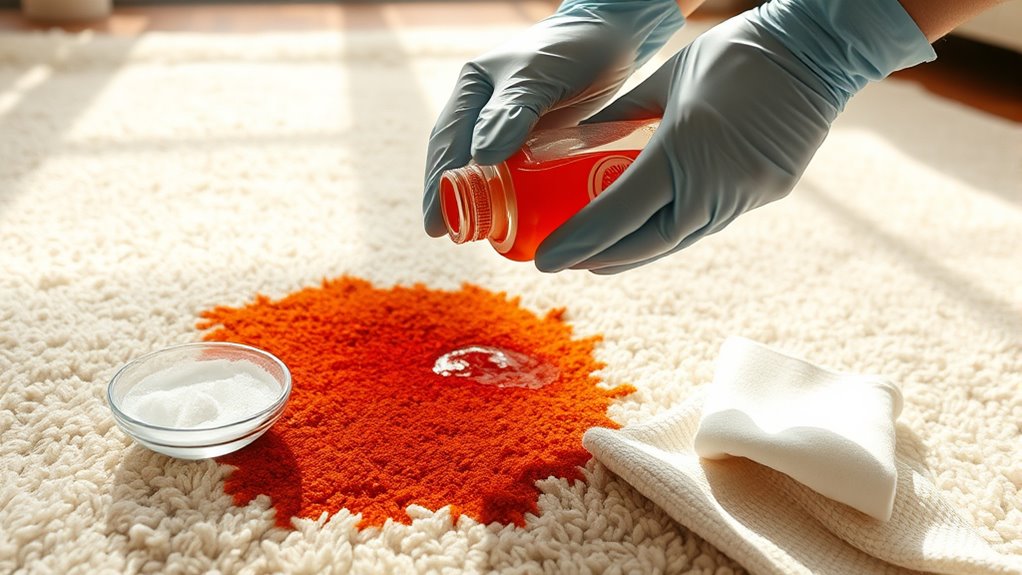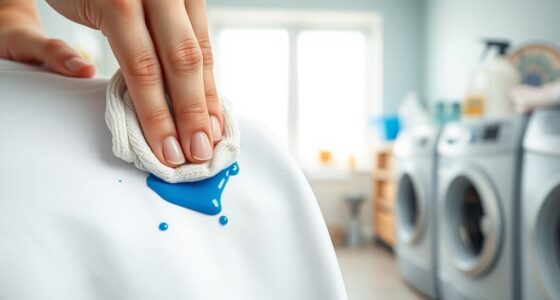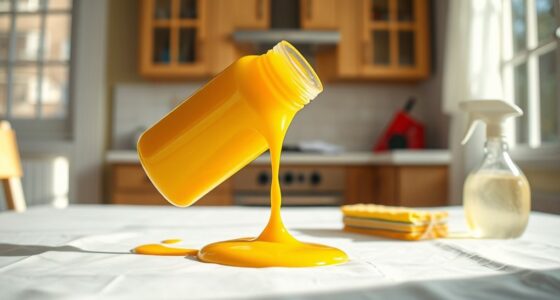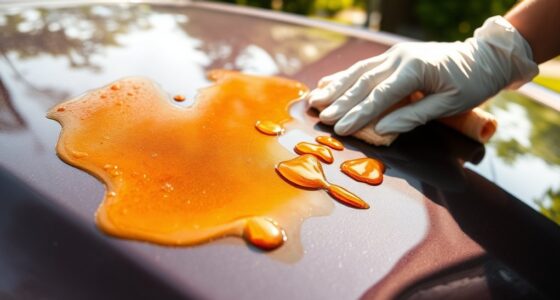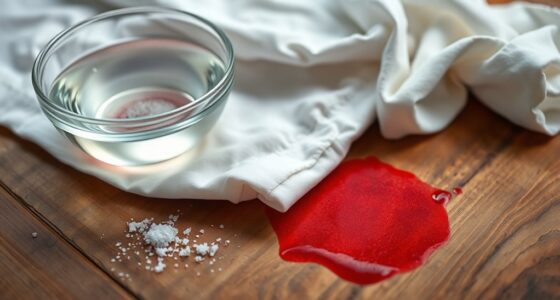To remove rust stains from fabrics and carpets, start by identifying the stain’s source and gently scraping off any loose rust. For fabrics, apply a mix of lemon juice and salt or vinegar and water, and let it sit before rinsing. For carpets, blot the area first, then use lemon juice or a vinegar solution. Rinse and dry the area thoroughly afterward. Want to know more tips and methods to prevent future rust stains? Keep exploring!
Key Takeaways
- Brush off loose rust before applying any cleaning solution to prevent further damage to fabrics or carpets.
- Use natural remedies like lemon juice and salt, or vinegar and water, to treat rust stains effectively.
- For stubborn stains, apply a baking soda paste and let it sit for at least 30 minutes before rinsing.
- Always conduct a spot test on an inconspicuous area before using commercial products to avoid fabric damage.
- Prevent future rust stains by using coasters under metal objects and controlling humidity levels in your environment.
Understanding Rust Stains and Their Sources
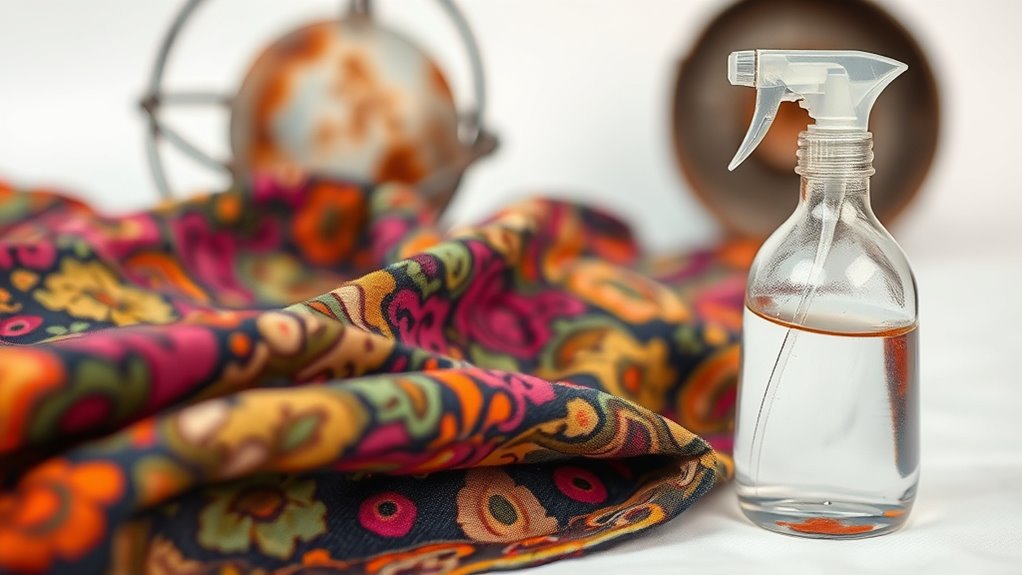
When you encounter rust stains, it’s essential to understand their origins and how they form. Rust is primarily composed of iron oxides, created through the oxidation of iron when it meets oxygen and water. This process can speed up with chemicals like salt, which increases corrosion. Rust is a reddish-brown oxide film that can form on various metals, contributing to the staining issue.
You’ll often find rust stains from contact with rusted metal objects, such as nails or screws, especially in moist conditions. Environmental factors like humidity can further exacerbate rust formation.
Be aware that rust stains can permanently damage fabrics and carpets if left untreated, making it vital to identify their sources promptly. Regular maintenance and moisture control can help prevent these unsightly stains from occurring in the first place.
Preparation for Effective Stain Removal
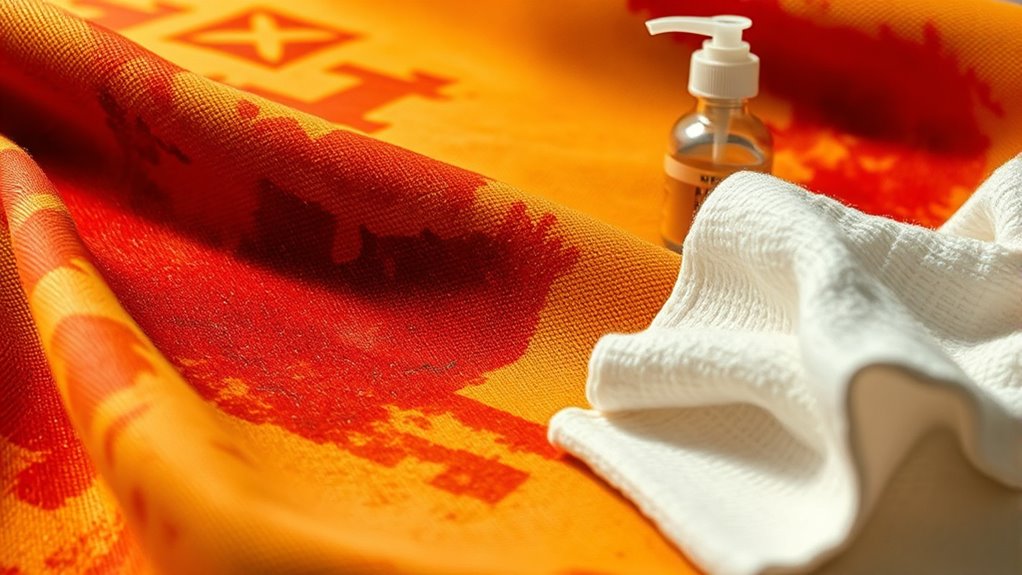
Before diving into stain removal, it’s essential to prepare properly to guarantee the best results. Start by identifying the stain’s type and severity, as this informs your cleaning approach.
Next, assess the fabric or carpet material to choose the right method. Gather necessary supplies like vinegar, lemon juice, or commercial rust removers, and don protective gloves and eyewear for safety.
Always conduct a spot test on an inconspicuous area to avoid damage. Consider the material type, weave, and colorfastness, ensuring that the cleaning solution won’t harm it. Additionally, be aware that rust stains can result from oxidation of iron, especially if the fabric has come into contact with metal fittings.
Methods for Removing Rust Stains From Clothing
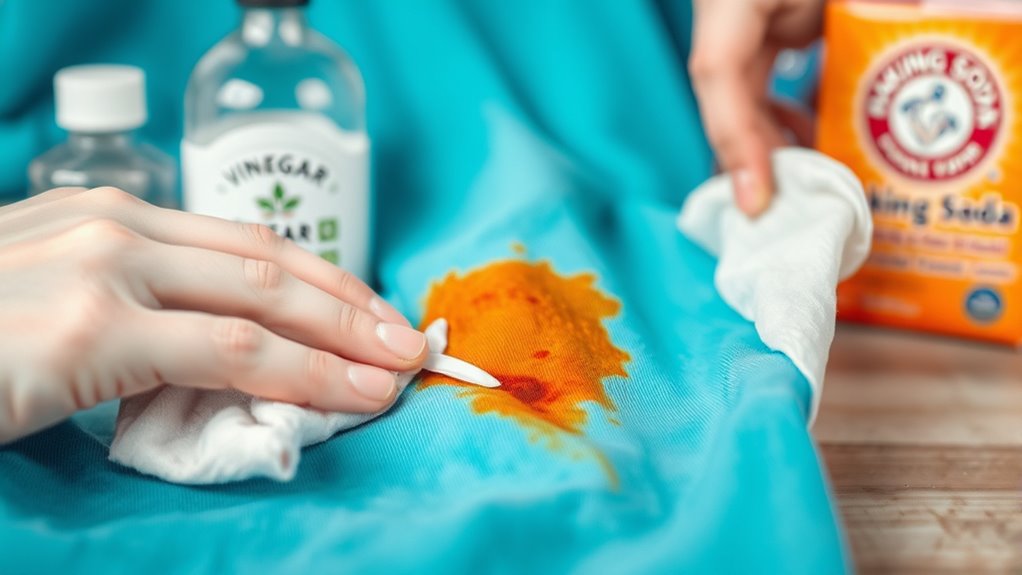
Removing rust stains from clothing can be straightforward if you know the right methods. Start by gently brushing off any loose rust.
Removing rust stains from clothing is easy when you follow the right steps. Begin by brushing off any loose rust.
For natural remedies, mix lemon juice and salt, or use a solution of equal parts vinegar and water to soak the stained area. You can also create a paste from baking soda and apply it for at least 30 minutes. It is important to remember that prompt action is essential for effective removal, as stains may be challenging to eliminate if left untreated.
If you prefer commercial products, Tide detergents and HG Stain Away No. 7 are effective options. Always test any solution on a hidden spot first to check for colorfastness.
After treating the stain, wash the garment as recommended but avoid drying until you’re sure the stain is gone, as heat can set it permanently.
Techniques for Treating Rust Stains on Carpets
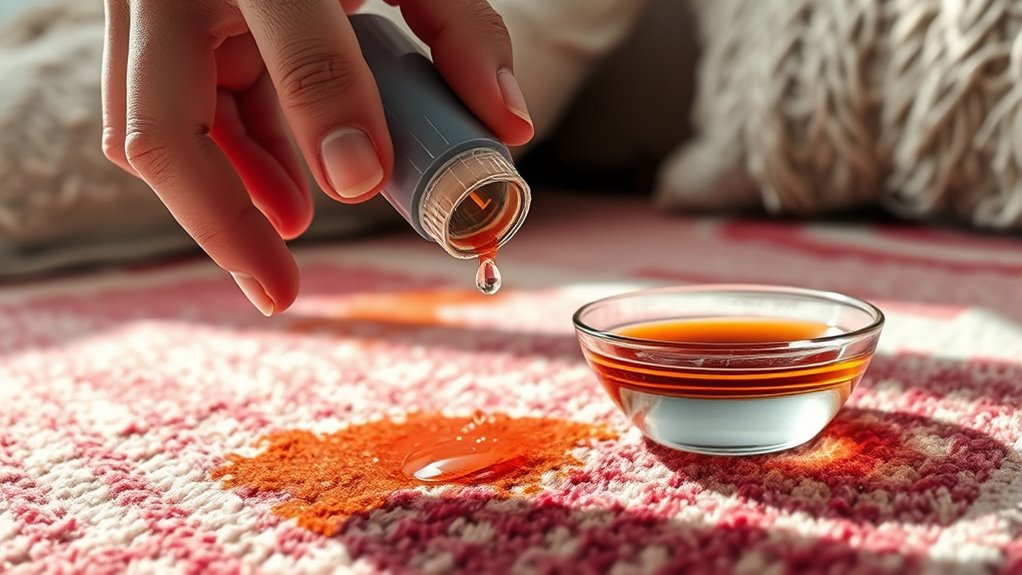
Rust stains on carpets can be just as frustrating as those on clothing, but effective techniques can help you tackle them.
Start by identifying the stain’s source and gently scraping away any loose rust with a butter knife. Blot the area to remove excess moisture using a clean cloth.
For treatment, apply lemon juice directly to the stain and let it sit for 5-10 minutes. Alternatively, mix white vinegar with water or create a baking soda paste to scrub the stain. Always test cleaning solutions in a hidden area before applying them directly to the rust stain to avoid damaging your carpet.
After applying any solution, rinse the area thoroughly with water and blot it dry. Repeat the process if needed, and always check an inconspicuous area first to avoid damaging your carpet.
Tips for Preventing Future Rust Stains
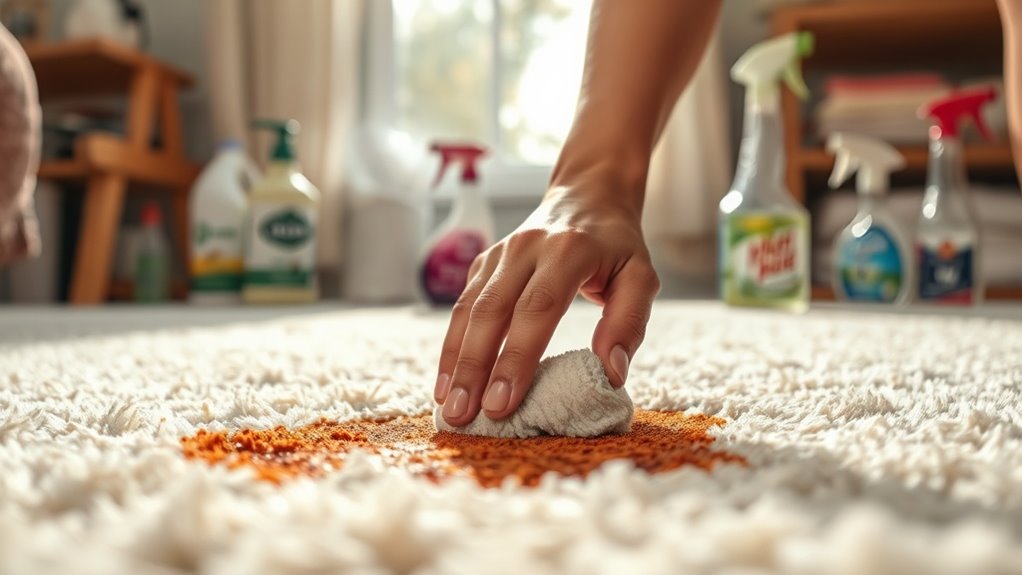
To keep your carpets looking fresh and free from rust stains, it’s crucial to take proactive measures.
Start by placing protective barriers or coasters under metal furniture legs to prevent rust transfer. Regularly vacuum and clean your carpets to minimize moisture retention. If you live in a humid area, consider using a dehumidifier to control humidity levels. Maintaining a clean and dry environment is essential in preventing rust stains from forming on carpets.
Always clean up spills promptly to avoid moisture buildup. Position metal items away from carpeted areas whenever possible, and apply rust-resistant coatings to metal objects to reduce corrosion.
Regularly inspect all metal surfaces for signs of rust and verify they’re sealed or coated.
Frequently Asked Questions
Can Rust Stains Be Removed From Leather Fabrics?
Yes, you can remove rust stains from leather fabrics, but it requires caution.
Start by testing a gentle cleaner on a hidden area to avoid damage. You might try a specialized leather stain remover or a mixture of vinegar and water.
Remember, leather is delicate, so use soft cloths and avoid harsh chemicals.
After cleaning, apply a leather conditioner to restore its shine.
Regular maintenance can help prevent future stains.
Are There Special Considerations for Washing Silk With Rust Stains?
When washing silk with rust stains, you’ve got to be extra careful.
Always test any cleaning solution on a hidden spot first. You can try using a diluted mixture of vinegar or lemon juice, but watch for color changes.
Avoid bleach, as it’ll ruin the fibers. Hand washing is safer, and remember to dry it flat, away from direct sunlight, to keep your silk looking beautiful and intact.
What Should I Do if Stains Persist After Treatment?
If at first you don’t succeed, try, try again!
When stains persist after treatment, you should reassess your methods. Consider reapplying your cleaning solution or switching to a commercial product designed for tough stains.
If that doesn’t work, a professional cleaner might be your best bet. Always remember to spot test any new solution and guarantee good ventilation while you work.
Don’t give up; persistence often pays off!
Is It Safe to Use Vinegar for Rust Stain Removal?
Yes, it’s generally safe to use vinegar for rust stain removal, but you need to take precautions.
Wear protective gloves and goggles to prevent skin and eye irritation. Make sure you’re in a well-ventilated area to avoid respiratory issues from the vapors.
Always test on a small, inconspicuous area first, especially on delicate materials, and consider diluting the vinegar with water to reduce its acidity for safer application.
How Can I Avoid Damaging My Carpet While Cleaning Rust Stains?
When you’re faced with a stubborn stain, it can feel like a battle against an unyielding foe.
To avoid damaging your carpet while cleaning rust stains, always pre-test your cleaning solutions in a hidden spot. Use clean, white cloths to prevent color transfer and gently blot rather than rub the stain.
Before applying any solution, make certain the carpet’s free of debris, and always follow the manufacturer’s care instructions for the best results.
Conclusion
To sum up, tackling rust stains doesn’t have to feel like searching for a needle in a haystack. With the right methods and a bit of elbow grease, you can restore your fabrics and carpets to their former glory. Just remember to act quickly and keep an eye out for potential sources of rust in your home. So, roll up your sleeves and get ready to banish those stains—your space will thank you, and you’ll feel like a modern-day superhero!
